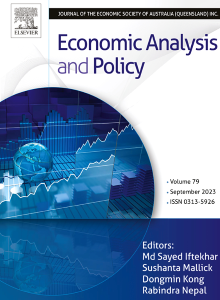Does ISO 50001 adoption reduce manufacturing energy intensity? Micro-evidence from China
IF 7.9
2区 经济学
Q1 ECONOMICS
引用次数: 0
Abstract
Numerous qualitative case studies suggest that ISO 50001 Energy Management System (ISOEnMS) effectively enhances organizational energy performance. However, empirical evidence is lacking to substantiate this claim and explore the potential mechanisms. This study addresses this gap by empirically examining the impact of ISO 50001 Energy Management System on energy intensity. We manually compiled information on all Chinese organizations that obtained ISOEnMS certification from 2011 to 2021 and matched this data with micro-level data from manufacturing firms spanning 2007 to 2016. Using a propensity score matching difference-in-differences approach, we analyzed the impact of ISOEnMS on energy intensity and explored potential mechanisms. Our findings reveal that firms with ISOEnMS certification experience a reduction in energy intensity of approximately 26 %. This reduction is primarily driven by increased investments in energy-efficient technologies, specifically through the acquisition of high-efficiency equipment, and increased external financing at lower costs. Additionally, the reduction in energy intensity is more pronounced in firms with higher management efficiency, those that purchase external energy services, non-state-owned enterprises, foreign-invested firms, firms with lower financing constraints, exporting firms, and firms that import coal. Finally, ISOEnMS does not appear to promote a shift towards cleaner energy sources, such as electricity. These findings underscore the effectiveness of ISOEnMS in reducing energy intensity while also highlighting its limitations in facilitating an energy transition.
ISO 50001的采用是否降低了制造业的能源强度?来自中国的微观证据
大量定性案例研究表明,ISO 50001能源管理体系(ISOEnMS)有效地提高了组织的能源绩效。然而,缺乏经验证据来证实这一说法并探索潜在的机制。本研究通过实证检验ISO 50001能源管理体系对能源强度的影响来解决这一差距。我们手工编制了2011年至2021年获得ISOEnMS认证的所有中国组织的信息,并将这些数据与2007年至2016年制造企业的微观数据进行了匹配。利用倾向得分匹配差异中的差异方法,我们分析了ISOEnMS对能源强度的影响,并探讨了潜在的机制。我们的研究结果显示,获得ISOEnMS认证的公司的能源强度降低了约26%。减少的主要原因是增加了对节能技术的投资,特别是通过购置高效率设备和以较低成本增加外部资金。此外,能源强度的降低在管理效率较高的企业、购买外部能源服务的企业、非国有企业、外商投资企业、融资限制较低的企业、出口企业和进口煤炭的企业中更为明显。最后,ISOEnMS似乎并没有促进向更清洁能源(如电力)的转变。这些发现强调了ISOEnMS在降低能源强度方面的有效性,同时也强调了其在促进能源转型方面的局限性。
本文章由计算机程序翻译,如有差异,请以英文原文为准。
求助全文
约1分钟内获得全文
求助全文
来源期刊

Economic Analysis and Policy
ECONOMICS-
CiteScore
9.80
自引率
9.20%
发文量
231
审稿时长
93 days
期刊介绍:
Economic Analysis and Policy (established 1970) publishes articles from all branches of economics with a particular focus on research, theoretical and applied, which has strong policy relevance. The journal also publishes survey articles and empirical replications on key policy issues. Authors are expected to highlight the main insights in a non-technical introduction and in the conclusion.
 求助内容:
求助内容: 应助结果提醒方式:
应助结果提醒方式:


